

Drone strikes botanical gold. When drones (also known as unmanned aerial vehicles, and Remotely Piloted Aerial Systems) are mentioned without qualification, one’s knee-jerk thought is of remotely-operated weaponised aircraft that deal death from the skies as various governments or their agents ‘liquidate’ enemies of the state.

Plant Image Analysis - Software. Generic workflow for effective sampling of environmental vouchers with UUID assignment and image processing. Skip to Main Content Sign In Register Close Advanced Search.
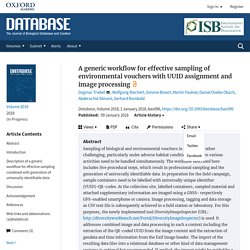
Better Herbarium Specimen Images with FineFocus. Imaging Roots: The Hidden Half of Plants. Plant roots are highly versatile structures with key functions that enable the plant to survive in the natural environment.

They act to absorb water and nutrients from the soil, provide anchoring to the ground, storage for food and nutrients and also allow the plant to explore and colonise new regions of land via vegetative propagation. The shape and structure of the root system as a whole can be complex with both genetic and environmental factors influencing their form. Understanding how plant root system architecture develops is of fundamental importance to our future food security by helping us to breed more efficient varieties of crops that can produce high quality foods in the face of increasing environmental threats such as global climate change and soil degradation. However, studying plant roots in soil is a challenging task. If you dig a plant from the soil in your garden, you’ll quickly discover that it is a destructive process. A Statistical Description of Plant Shoot Architecture. Exploring trees in three dimensions: VoxR, a novel voxel-based R package dedicated to analysing the complex arrangement of tree crowns.
Terrestrial LiDAR:3-D look at trees. LiDAR-Based 3D Morphological Traits in Maize and Sorghum. What’s This Bird? Classify Old Natural History Drawings with R. This post was originally published on the rOpenSci blog on 28 August 2018 and is republished with permission of the author, Dr.

Maëlle Salmon, and rOpenSci. Armed with rOpenSci’s packages binding powerful C++ libraries and open taxonomy data, how much information can we automatically extract from images? Maybe not much, but, experimenting with gorgeous drawings from a natural history collection, we can least explore image manipulation, optical character recognition (OCR), language detection, and taxonomic name resolution with rOpenSci’s packages. Free natural history images and appropriate R tooling! A long time ago I had bookmarked the Flickr account of the Biodiversity Heritage Library (BHL). ePlant: Data Visualization Tool for Plant Biologists. The advent and breadth of bioinformatics resources have made scientist’s jobs easier.

Before jumping into wet lab work, they are able to parse gene targets and construct better hypotheses. Several groups and research institutes have taken the initiative to provide datasets, tools, algorithms, open source code, and visualization platforms. A comprehensive study of a gene or protein requires enlisting multiple online tools, databases, and visualization platforms. Functional imaging at different size levels in plant specimens. 3-D printed flowers to differentiate between insect attraction: odor/vision. Answer: Printing flowers (of course!).
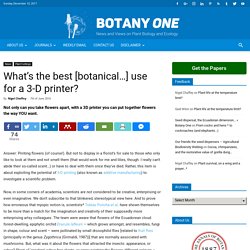
But not to display in a florist’s for sale to those who only like to look at them and not smell them (that would work for me and lilies, though. I really can’t abide their so-called scent…) or have to deal with them once they’ve died. Rather, this item is about exploiting the potential of 3-D printing (also known as additive manufacturing) to investigate a scientific problem. Now, in some corners of academia, scientists are not considered to be creative, enterprising or even imaginative. Plant Illustrations Repository. International Image Interoperability Framework. Access to image-based resources is fundamental to research, scholarship and the transmission of cultural knowledge.
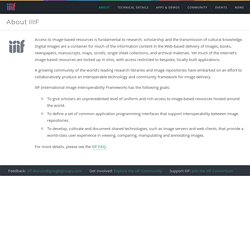
Digital images are a container for much of the information content in the Web-based delivery of images, books, newspapers, manuscripts, maps, scrolls, single sheet collections, and archival materials. Yet much of the Internet’s image-based resources are locked up in silos, with access restricted to bespoke, locally built applications. A growing community of the world’s leading research libraries and image repositories have embarked on an effort to collaboratively produce an interoperable technology and community framework for image delivery.
IIIF (International Image Interoperability Framework) has the following goals: Phone-Powered AI Spots Sick Plants With Remarkable Accuracy. Scanning height and volume of trees with laser beams. A new way to ‘see’ the water in tall trees. Tall trees can experience water limitations even when soil water is readily available.
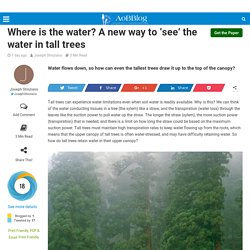
Why is this? We can think of the water conducting tissues in a tree (the xylem) like a straw, and the transpiration (water loss) through the leaves like the suction power to pull water up the straw. The longer the straw (xylem), the more suction power (transpiration) that is needed, and there is a limit on how long the straw could be based on the maximum suction power. X-ray CT toolchain for tree-ring analysis. Disentangling tree growth requires more than ring width only.
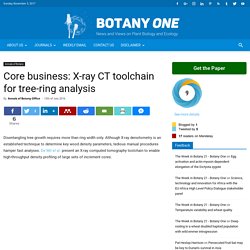
Although X-ray densitometry is an established technique to determine key wood density parameters, tedious manual procedures hamper fast analyses. De Mil et al. present an X-ray computed tomography toolchain to enable high-throughput density profiling of large sets of increment cores. The obtained 3D archive is analysed via software routines with which traditional tree-ring analysis, as well as semi-automated density-based pattern matching, can be performed. The toolchain allows fast assessment of newly sampled increment cores, without any surface treatment or visual inspection. Remarkable Photos Capture the Light That Plants Emit.